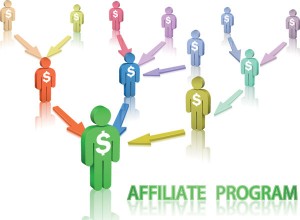
Affiliate marketing constitutes an effectual online communication practice which seeks to engage users on third-party sites and generate new leads into a company’s or organization’s website. Affiliate marketing prompts users to click through referring sites (publishers) to a company’s website to ACT either this means purchase, submit information that allows an interactive relationship (newsletter subscription) or get benefit from special vouchers or offers which can be used in-store.
Part of Online business strategy
In the context of acquisition strategies and tactics, affiliate marketing plays a significant role, yet it should be considered as a part of a holistic strategy approach. The RACE planning framework illustrates key steps on organising effective online business:
REACH: acquisition strategies for brand building tactics (affiliate marketing – SEO – PPC techniques – Online PR – Social Media marketing etc.)
ACT & CONVERT: tactics that lead to measurable actions. (Lead generation techniques – e-commerce management – home page / landing page optimization etc.)
ENGAGE: retention and growth tactics to turn one time visitors into repeaters. (Content marketing actions – newsletters and promotional techniques – mobile marketing – ongoing customer support)
Payments policies
Its profit potential and measurable results has evolved affiliate marketing through the past years into a popular media channel. Affiliate marketing involves commission based payments such as pay per click(payment is related with clicks on the link and it is usually a low paying technique) or pay per action ( payment is related directly and only with actions performed (Cost per Acquisition (CPA) which can be very effective compared to PPC which is used more for traditional online ads.
Generally it is estimated that gradually CPA tends to replace CPM or CPC as the advertiser has increased intervention control over the percentages agreed. “For example, in 2005 manufacturing company Unilevernegotiated CPA deals with online publishers where it paid for every e-mail address captured by a campaign rather than a traditional CPM deal.”
The cost per acquisition can be calculated as follows:
CPA= 100 / conversion rate% * CPC
The affiliates or publishers can follow the performance progress by the earnings per click (EPC) which is a metric used to indicate average earning per 100 outbound clicks generated.
It is significant to note that apart commission percentages, there are also network and placement fees along with agency management fees. What matters is to achieve your revenue goals and still retain yourROAS target (return on ad spends). What is more, it is efficient to keep aside a part of your estimated budget for paid placements, further publicity actions and testing.

Models of affiliate marketing
There are several options and models of affiliate marketing such as:
- Aggregators sites (comparison sites)
- Shopping directories
- Review sites
- Loyalty sites: rewards sites
- Voucher or coupon sites
- E-commerce sites
- Personal or blog sites
Pros and Cons of Affiliate Marketing
Below we list the most important pros and cons of Affiliate Marketing:
| Advantages | Disadvantages |
|---|---|
|
|
4 Tips in affiliate marketing management
1. Commission management
In affiliate marketing, it is vital that commission is calculated on a level that it motivates affiliates to preferentially support a merchant’s products, while at the same time being cost-effective.
2. Cookie expiry period
Affiliates’ EPC will be also affected by the cookie expiry period agreed on the time between a visitor clicks the affiliate link and the sale is certified to the affiliate.
3. Content
Managing the design and content which affiliates use to advertise a company constitutes a challenge since content needs to be current in line with different promotions. So this needs to be monitored by the affiliate manager on a constant base. Many merchants now provide live product feeds to affiliate networksin order to keep their promotions and product pricing up-to-date.
4. Select the right channels
It is vital to fulfill the most effective selection upon the affiliate’s partner network and constantly review its progress. A static allocation of your budget can be detrimental. Consumers shop via different channels and change their habits and preferences often.




No comments:
Post a Comment